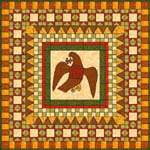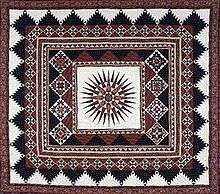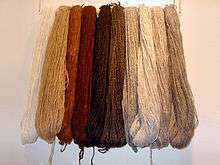History of quilting

Quilting, the stitching together of layers of padding and fabric, may date back as far as ancient Egypt.[1]
Europe

In Europe quilting appears to have been introduced by Crusaders in the 12th century (Colby 1971), in particular in the form of the aketon or gambeson, a quilted garment worn under armour which later developed into the doublet.
One of the earliest existing decorative works is the Tristan quilt,[2] made around 1360. Made in Sicily, and as one of the earliest surviving quilts in the world, at least two sections survive at the V&A Museum (London) and in Bargello palace (Florence). Another of the Tristan and Isolde story is held in a private collection.
Russia
Russia holds the oldest example in existence. It is a quilted linen carpet found in a Mongolian cave, and now kept at the Saint Petersburg department of the Russian Academy of Sciences, Archaeology Section.[3]
United States
Quilt making was common in the late 18th century and early years of the 19th. Most women were busy spinning, weaving and sewing in order to clothe their family. Commercial blankets or woven coverlets were a more economical bedcovering for most people. Only the wealthy had the leisure time for quilt making so Colonial quilting was done by only a few.
Obviously quilts were not made of left over scraps or worn clothing as a humble bedcovering during this period. Instead they were decorative items that displayed the fine needlework of the maker such as the Baltimore album quilts.
Whole cloth quilts, broderie perse and medallion quilts were the styles of quilts made during the early 19th century.
According to the Wall Street Journal there are an estimated twenty-one million quilters in the United States.[4]
Wholecloth quilts
Early wholecloth bed quilts which may appear to be a solid piece of fabric are actually composed of strips of fabric, inasmuch as early looms could not produce expansion of cloth large enough to cover an entire bed surface. Early quilts that feature the same fabric for the entire quilt top, whether that top is made of dyed wool or pieces of (the same) printed cotton fabric, are referred to as wholecloth quilts. Early wholecloth quilts have three layers: a quilt top, a filling (in early quilts the filler was often wool), and a backing. The three layers are held together via quilting stitches worked by hand, in an age before sewing machines were marketed. In wholecloth quilts, the quilting stitches themselves serve as the only decoration. The earliest whole cloth quilts found in America were brought from Europe. Initially, quilts were owned by the wealthy in America who had the means to purchase imported quilts.
The Lovely Lane Museum, Baltimore, Maryland, holds a quilt in their collection believed to have been carried onshore by the Cogswell family who embarked from Bristol, England en route to Bristol, Maine in 1635. Once the passengers were safely on shore, the galleon "Angel Gabriel, moored in Pemaquid Bay, was completely destroyed when the Great Hurricane of 1635 rushed up the coast from Naragansett, Rhode Island, leaving the ship as just a mass of floating debris after it was hit with the strongest winds ever recorded. The story is recounted in an article written by Patricia L. Cummings titled "Quilts in Early America, Part I: The Oldest Known Wholecloth Quilt Brought to the New World," published in The Quilter magazine (Stanhope, NJ: All-American Crafts, Inc., February/March 2014).
The Canton Historical Society, Canton, Massachusetts, believes that a wholecloth quilt in their collection may be the oldest wholecloth quilt made in America. An article published in The Quilter magazine, April/May 2014, titled "Early American Quilts in America, Part II: The Martha Crafts Howard Quilt" by Patricia L. Cummings offers details of the wool wholecloth quilt made in 1786 by Martha Crafts Howard, whose life stories are also shared in that article.
In 2005, quilt historian, Patricia L. Cummings, wrote a series of five articles that explore the art of wholecloth quilting published them on her website, Quilter's Muse Publications. That particular series includes information about the wholecloth quiltmaking tradition of some European countries and features photos provided by contributors to the articles.
In March 2014, Cummings added two new articles to Quilter's Muse Publications' website: "Wholecloth Quilts: Yesterday and Today"; and "Andrea Stracke - Wholecloth Quilts," which offers photo examples of quilts made by a wholecloth quilt artist who lives in Germany.
A more complete survey is needed to compare all of the wholecloth quilts held in the many museum locations who have collected such textiles. Many early quilts did not survive the test of time or were discarded, or else, they survived but the name of the quilter is lost to history. For a time, the trend in wholecloth quilting was a preference for all-cotton white quilts.
Many of the beautiful surviving wholecloth quilts feature feather designs, outlines of flowers, or are based on other designs taken from nature motifs. Some were made even more exquisite by the use of stuffed and corded quilting, a method sometimes called trapunto. Trapunto is an Italian word used to describe the technique of slipping extra stuffing into certain areas of a quilt to create areas of raised motifs that stand in relief. For example, stuffing placed inside the quilted outline of a feather or flower makes the design stands out. Women were sometimes proud of their finely wrought and evenly spaced quilting stitches in their wholecloth quilts. This type of quilting seems to be experiencing a revival today and some quilt stores sell pre-marked quilt tops ready to be layered and quilted, either by hand or by machine.
Broderie perse quilts
Broderie perse refers to the applique of cut out motifs from printed fabric onto a solid background. This form of quilt making has been done since the 18th century. The popular printed fabric during this period was chintz imported from India.
Printed fabric was expensive even for those who were well off. By cutting out birds, flowers and other motifs from printed fabric and sewing them onto a large homespun cloth a beautiful bedspread could be made. The technique was also used on some early medallion quilts as in the example.
Broderie Perse bedcoverings were usually used on the best bed or sometimes only when guests were staying in the home.

Medallion quilts

Medallion quilts are made around a center. The center was sometimes a solid piece of large-scale fabric like a toile or a Tree of Life, an appliqued motif or a large pieced star or other pieced pattern. The central area was surrounded by two or more borders. Although some borders were solid, many were pieced or appliqued.
Mid-19th century
Changes came about as progress in technology deeply affected the number and styles of quilts made during the middle years of the 19th century.
The industrial revolution brought about the most dramatic change as textiles came to be manufactured on a broad scale. This meant women no longer had to spend time spinning and weaving to provide fabric for their family’s needs. By the 1840s the textile industry had grown to the point that commercial fabrics were affordable to almost every family. As a result, quilt making became widespread.
A great variety of cotton prints could be bought to make clothing and even specifically for making a quilt. Although scraps left over from dressmaking and other sewing projects were used in quilt making, it is a myth that quilts were always made from scraps and worn out clothing. Examining pictures of quilts found in museums we quickly see that many quilts were made with fabric bought specifically for that quilt.
Another major shift was in the style of quilts made. Although a few earlier quilts were made in the block style, quilts made up of blocks were uncommon until around the 1840s. With so many fabrics being manufactured quilters could create their blocks with a delightful variety of fabrics.
Some block style quilts were made of a set of identical pieced blocks while others contained a variety of blocks made with different patterns. The blocks were sewn together and a border may or may not have been added.
During this period the invention and availability of the sewing machine contributed to quilt making. In 1856 The Singer company started the installment plan so that more families could afford a sewing machine. By the 1870s a good many households owned a sewing machine.
This affected quilt making in two ways. First of all women could make clothing for their family in much less time leaving more time for quilt making and secondly they could use their sewing machines to make all or part of their quilts. More often the sewing machine was used to piece quilts but occasionally the quilting itself was done with the sewing machine.

Civil War era
Leading up to the American Civil War, quilts were made to raise funds to support the abolitionist movement then during the war, quilts were made to raise funds for the war effort and to give warmth and comfort to soldiers. The patterns were much like those made mid-century but the purpose was different. Quilts connected to the abolitionist movement and the Civil War were made for a cause, many representing the relevant flag.
Abolition and the role of quilts
Even before 1830, abolitionists were working hard to end slavery. One way they did this was to hold grand fairs to raise both awareness and money for the abolitionist cause. Quilts were one of many craft pieces sold at these fairs. These quilts were usually fine quilts often with beautiful appliqué. Women sometimes put anti-slavery poems and sayings on the quilts they made for fairs as well as for friends and family. The goal was to show the terrible plight of the slaves.
Some abolitionists were active in the Underground Railroad helping runaway slaves get to safety. There are stories that certain quilts were used as signals to help the slaves in their flight to freedom. The idea that a log cabin quilt would be hung on the line of a safe house was one. More recent stories tell of certain quilts being used to tell the slaves what they needed to do to get to safety. This all sounds quite romantic but historians are divided on the theory and legend. But we do know that a valiant effort was made by both whites and free slaves to help these slaves to their destination.
For the troops

Women on both sides were very active in raising money for the war effort and making quilts and other bed coverings for soldiers.
In the North, quilts were still made for fairs but now these fairs earned money to support needs that came about because of the war. In the South lovely quilts called "gunboat" quilts were made to pay for much-needed gunboats.
It wasn't long before it was obvious that soldiers on both sides would need blankets and quilts for warmth. In the North, women either made quilts or remade quilts from bed coverings. Since the cots were narrow two bedspreads could be made into three quilts for soldiers. The United States Sanitary Commission was in charge of collecting distributing them.
In the South, it was more difficult because cotton was grown in the south but manufactured into fabric in the north. Before long, fabric was almost impossible to obtain so women had to spin and weave before they could sew a bed covering together. Needless to say most of the quilts made for soldiers on either side were made with practical patterns and fabric and due to heavy use, very few have survived to this day.
Victorian era America
Quilt making continued to be a popular craft during the latter part of the 19th century. The English Victorian influence was slightly delayed in the United States because of the Civil War and its aftermath.
Amish quilting
Amish quilts are appreciated for their bold graphic designs, distinctive colour combinations, and exceptional stitching. Quilting became a favoured activity of the Anabaptist sect after emigrating to the United States and Canada from Germany and Switzerland over 250 years ago. The earliest known Amish quilts, dating from 1849, are whole-cloth works in solid colours. Pattern-pieced bed coverings didn't appear until the 1870s. Particular patterns and fabrics are identified with specific Amish communities; for example, pre-1940s quilts from Lancaster County were almost always made of wool while those sewn in Ohio during the same period were commonly made of cotton.[5]
Often these quilts provide the only decoration in a simply furnished home and they also were commonly used for company or to show wealth. Amish religion discourages individual expression but quiltmaking has allowed Amish women to express their creative natures without giving offence. The Amish communities have always encouraged activities that promote community and family closeness so quilting became a fundamental part of social life for the women of the community. Quilts are created for everyday use or to celebrate special occasions such as birthdays, weddings, raising funds for the church or community cause. Since the “English” (the name for non-Amish people) discovered Amish work in the late 1960s, quilting has become a source of income for many. Their quilts have become collectors’ items all over the world.[6]
Crazy quilting fad
In terms of quilts the latter years of the 19th century is best remembered for the "Crazy quilting" craze. Crazy quilts were made of abstract shapes sewn randomly together. Usually the quilt maker then used embroidery to embellish the quilt. Fancy stitches were sewn along the seams and often, embroidered motifs were added, including flowers, birds and sometimes a spider and web for good luck. Magazines encouraged making "crazies". Young women were particularly eager to make them. These simple, organic quilts were seldom used as bed-coverings, instead they were made smaller and without batting to be used as decorative throws.
Traditional quilt survival
Because crazy quilting was so popular at the time, they tend to eclipse the fact that many traditional quilts were also made for bedding and commemoration. Utilitarian quilts were pieced and tied or simply quilted for everyday bed coverings while beautiful pieced and/or appliquéd quilts were created for special events like a wedding or when a beloved minister was transferred to a new location. These were more often elaborately quilted.
Art quilts
Art quilts evolved from crazy quilt, where cloth and thread became the tools to create works of art.
Concise on quilting
The art of quilting was once important and large part of women and young girl’s life. Over time it has turned into a popular hobby for women that have a passion for fabric and sewing. Rumors of how the quilt was used during the Civil War to aid the Underground Railroad has given a sense of mystery and adventure to the meaning of quilts, but these are just rumors with no actual evidence. The amount of time and effort that goes into the creation of a quilt makes these “fabric sandwiches” not only expensive to create and sometimes purchase, but produces a priceless family heirloom that should be passed down from generation to generation.
References
- ↑
- ↑
- ↑ Cf. Carolyn Ducey, "Quilt History Timeline".
- ↑ http://www.wsj.com/articles/SB10001424052702303277704579349133544709954
- ↑ Levie, Eleanor; Place, Jennifer; Sehafer Sears, Mary (1992). Country Livings Country Quilts, p. 98. Hearst Books, New York. ISBN 0-688-10620-X.
- ↑ Levie, Eleanor; Place, Jennifer; Sehafer Sears, Mary (1992). Country Livings Country Quilts, p. 98. Hearst Books, New York. ISBN 0-688-10620-X.
Further reading
Primary sources
Books
- Barbara Brackman. "Clues in the Calico: A Guide to Identifying and Dating Antique Quilts." Howell Press, 1989.
- Celia Eddy, "Quilted Planet A Source Book of Quilts from Around the World. 2005.
- Sandi Fox. "For Purpose and Pleasure: Quilting Together in Nineteenth-Century America." Rutledge Hill Press, 1995.
- Laurel Horton (ed.), "Quiltmaking in America: Beyond the Myths." Rutledge Hill Press, 1994.
- Roderick Kiracofe and Mary Elizabeth Johnson, "The American Quilt: A History of Cloth and Comfort 1750–1950." Clarkson Potter, 2004.
- Janneken Smucker, Amish Quilts: Crafting an American Icon. Baltimore, MD: Johns Hopkins University Press, 2013.
Articles
- Ducey, Carolyn, "Quilt History Timeline, Pre-History – 1800", International Quilt Study Center, University of Nebraska, Lincoln.
External links
- Baltimore Album quilts at the Maryland Historical Society
- The American Quilt Study Group
- America's Quilting History
- New Pathways Into Quilt History
- Quilt History
- The Quilt Index
- Quilt Study Groups
- Quilter's Muse Publications

